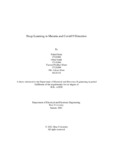| dc.contributor.advisor | Mohsin, Abu S.M. | |
| dc.contributor.author | Islam, Nahid | |
| dc.contributor.author | Sadat, Omar | |
| dc.contributor.author | Shaer, Tazwar Prodhan | |
| dc.contributor.author | Islam, Md. Adnan | |
| dc.date.accessioned | 2021-08-01T04:54:11Z | |
| dc.date.available | 2021-08-01T04:54:11Z | |
| dc.date.copyright | 2021 | |
| dc.date.issued | 2021-01 | |
| dc.identifier.other | ID: 17321002 | |
| dc.identifier.other | ID: 17121084 | |
| dc.identifier.other | ID: 17121094 | |
| dc.identifier.other | ID: 16121131 | |
| dc.identifier.uri | http://hdl.handle.net/10361/14879 | |
| dc.description | This thesis is submitted in partial fulfillment of the requirements for the degree of Bachelor of Science in Electrical and Electronic Engineering, 2021. | en_US |
| dc.description | Cataloged from PDF version of thesis. | |
| dc.description | Includes bibliographical references (pages 76-81). | |
| dc.description.abstract | Recent days deep learning is a promising field of research which has been used in biological
applications. It is deep learning which is used in biological image detection along with the
transformation of analysis data and also in interpreting those data. The revolution of DL enables
the researchers and scientists in a practical manner that they can easily analysis the difficult
data within very short period and more accurate way that was previously considered
impossible. Here we will study the intersection between deep learning with computer image
analysis that are pertinent to life scientists. We will study the principles of CNN, image
classification, different CNN models and lastly the Flask application. Later we will implement
deep learning with annotation of training data, selection of data and also present the training a
range of neural network architectures and finally the deploying solutions. Here will use four
different optimized neural network models named ResNet50, Inception_v3, Xception and
VGG-19 to find out among these which will give the most accurate and precise results. The
major purpose of our research is to find the model with the best accuracy for future use. From
our findings we see that the Xception model has the highest accuracy among the other models
we used. The conclusion points to the importance of implementing a proper model for detection
of diseases using images and DL for progress in health technology and future researches. | en_US |
| dc.description.statementofresponsibility | Nahid Islam | |
| dc.description.statementofresponsibility | Omar Sadat | |
| dc.description.statementofresponsibility | Tazwar Prodhan Shaer | |
| dc.description.statementofresponsibility | Md. Adnan Islam | |
| dc.format.extent | 81 Pages | |
| dc.language.iso | en_US | en_US |
| dc.publisher | Brac University | en_US |
| dc.rights | Brac University theses are protected by copyright. They may be viewed from this source for any purpose, but reproduction or distribution in any format is prohibited without written permission. | |
| dc.subject | Deep Learning | en_US |
| dc.subject | Neural Network | en_US |
| dc.subject | Training Data | en_US |
| dc.subject | Deploying flask | en_US |
| dc.subject | Datasets | en_US |
| dc.subject | Prediction | en_US |
| dc.subject | Diseases Detection | en_US |
| dc.title | Deep learning in Malaria and Covid19 detection | en_US |
| dc.type | Thesis | en_US |
| dc.contributor.department | Department of Electrical and Electronic Engineering, Brac University | |
| dc.description.degree | B. Electrical and Electronic Engineering | |

